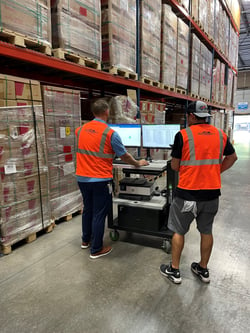
Managing a warehouse will always be challenging. You must ensure smooth operations while tackling a variety of ongoing risks and problems at the same time. This can result in problems with order fulfillment, inventory accuracy, supply chain visibility, and much more. Here are some of the most common warehouse management problems and how your business can address them.
1. Poor Inventory Management
Problems:
Poor inventory management continues to be one of the biggest struggles in warehouse management. This includes things like not having enough inventory on hand or having too much, misplacing products in the warehouse, having a misalignment between what’s on the shelf and what’s in your records, and damaging items due to improper handling.
Solutions:
Nearly all of these challenges can be addressed and solved through real-time inventory management and the use of a robust warehouse management system (WMS). Using solutions like RFID tags and a WMS allows your warehouse to get a real-time picture of what products are in stock so you can make more informed business decisions and manage inventory more efficiently.
2. Inefficient Space Utilization
Problems:
 As the demand for eCommerce goods explodes, the cost to store inventory continues to grow. Even if you believe your warehouse is packed to the brim, there’s a good chance you aren’t utilizing your space efficiently. It’s a common struggle in modern warehouses.
As the demand for eCommerce goods explodes, the cost to store inventory continues to grow. Even if you believe your warehouse is packed to the brim, there’s a good chance you aren’t utilizing your space efficiently. It’s a common struggle in modern warehouses.
Solutions:
Fortunately, today’s warehouses can use advanced technology solutions to map the current space and plan more effective layouts. For example, many warehouses aren’t making proper use of their vertical space to increase storage capacity. And using solutions like mobile powered carts can reduce the need for redundant office and administrative space.
3. Ignoring Seasonal Fluctuations
Problems:
If your warehouse isn’t making adjustments for seasonal demand, your business will face some serious challenges. For example, demand for many products skyrockets during the holiday season each year. But there are other seasons to consider as well, such as the summer and back-to-school seasons. If you don’t have sufficient stock on hand for consumer demand or too much of something no one wants, it can impact your business.
Solutions:
Warehouses can better prepare for seasonal demand by forming strong relationships with sellers and supply chain partners. Using advanced analytics is another way to predict consumer demand based on past activity and market trends so your business is making the right decisions at the right time.
4. Flawed Order Fulfillment Processes
Problems:
After inventory management, order fulfillment is one of the foundations of a smoothly running warehouse. If your warehouse isn’t picking, packing, and shipping orders efficiently, it’s going to impact the customer experience and your overall results.
Solutions:
 Most modern warehouses are implementing a variety of order fulfillment technology solutions that innovate these vital processes. For example, warehouses have begun investing in automation solutions like pick-to-light, wireless headsets, autonomous vehicles, RFID tags, and mobile powered carts to make the order fulfillment process more efficient and cost-effective.
Most modern warehouses are implementing a variety of order fulfillment technology solutions that innovate these vital processes. For example, warehouses have begun investing in automation solutions like pick-to-light, wireless headsets, autonomous vehicles, RFID tags, and mobile powered carts to make the order fulfillment process more efficient and cost-effective.
5. Supply Chain Delays
Problems:
Whether your warehouse still gets items from overseas or domestic sources, many businesses are still dealing with a variety of supply chain delays. These are fueled by factors like shipping and freight challenges, fuel costs, labor shortages, weather, and even war in different parts of the world.
Solutions:
While there’s no one-size-fits-all solution to supply chain delays, your warehouse can make some progress by combining a few different approaches. One is to diversify your supply chain partners so a single disruption won’t damage your business. Another is to use technology solutions like RFID tags so you can inject more visibility and traceability into the supply chain.
6. Ineffective Quality Control
Problems:
It’s not uncommon for human beings to make mistakes. But too many errors can negatively impact the productivity and efficiency of your warehouse, leading to damaged products, delayed fulfillment, injuries, and poor customer service. Today’s consumers will provide online feedback if they notice quality issues, which won’t bode well for your business, even if you are acting as a fulfillment partner.
Solutions:
Investing in the right warehouse automation technologies can help your warehouse improve its accuracy and overall efficiency. Things like RFID tags, a WMS, and mobile powered carts reduce the repetitive tasks that can result in needless errors. Better quality control will result in more satisfied customers and better overall business results.
7. Suboptimal Labor Management
Problems:
 High labor turnover, low worker satisfaction, and high labor costs are continuing warehouse problems. In fact, labor can account for roughly 60% of a warehouse’s total budget. When a distribution center doesn’t pay competitive wages and asks workers to do repetitive and labor-intensive work, there will likely be errors and low morale.
High labor turnover, low worker satisfaction, and high labor costs are continuing warehouse problems. In fact, labor can account for roughly 60% of a warehouse’s total budget. When a distribution center doesn’t pay competitive wages and asks workers to do repetitive and labor-intensive work, there will likely be errors and low morale.
Solutions:
Many warehouses are beginning to address ongoing labor issues with technology solutions that automate tedious and repetitive tasks like picking and packing. These solutions, like automated guided vehicles, autonomous mobile robots, and wearable technology for workers, make these tasks more efficient and cost-effective.
8. Lack of Sustainability
Problems:
Consumers increasingly want to support businesses that are good stewards of the environment. In addition to responding to consumer trends, warehouses must adhere to environmental regulations. Many warehouses have also found that making sustainability a priority is an excellent way to save costs long-term.
Solutions:
Operating a green warehouse has become more attainable as the solutions have become more affordable and available to everyday businesses. For example, your warehouse can save costs by switching to renewable energy sources, using more efficient lighting, and operating with hybrid or electric vehicles. It can also create goodwill with customers by using eco-friendly packaging and offering more digital solutions, like the online tracking of orders.
For the supply chain to operate efficiently, warehouses must perfect their management practices. While warehouse management challenges can be a major roadblock to productivity and efficiency, solving them can improve your operations, help you reduce costs, and shore up the supply chain so it can withstand future disruptions.












